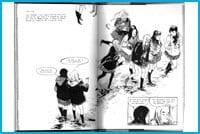
TAMAKI TIMES TWO. Writer Mariko Tamaki describes her graphic novel Skim, created with her illustrator cousin Jillian Tamaki, as a "gothic Lolita lesbian story." Credit: (Paula Wilson)
High school — the site of all drama. A fertile ground for the increasingly popular graphic novel. And, of course, the location of many a queer girl’s first crush. Cousins Mariko Tamaki and Jillian Tamaki return to high school in their new graphic novel Skim, out from Groundwood Books this March.
Toronto writer Mariko Tamaki describes the original concept behind Skim as a sort of “gothic Lolita lesbian story” told from the perspective of the Lolita. Set in 1993 the book follows a term in the life of Kimberly “Skim” Keiko Cameron, a 16-year-old Wiccan at an all-girls private school. The story weaves together two dramatic events: the suicide of a classmates’ exboyfriend (rumoured to be gay) and Skim’s brief involvement with the school’s hippie-esque English teacher Ms Archer. But beyond the more obvious drama, the graphic novel also deals with the shifting relationships between friends, the oddities of guidance counsellors and the everyday racism of children.
Now living in New York and working freelance as an illustrator, Jillian Tamaki went to ACAD in Calgary to become a graphic designer. “[I didn’t know] illustration even existed before I was being taught how to do it in school,” says Jillian. “I naturally gravitated to it and that’s sort of the end of the story.” After a stint at a videogame company in Edmonton she went freelance full time and now illustrates for publications like The Walrus and The New York Times.
Meanwhile, Mariko Tamaki has been long active in the writing, performance and queer scene in Toronto. Her previously published books include Cover Me (also set in high school) and Fake ID. She is currently working on a PhD in linguistic anthropology at the University of Toronto. She’s also been working on a comic for DC called Emiko Superstar (drawn by Vancouverite Steve Rolston), about a girl trying to get into the alternative performance arts scene in downtown Toronto.
The cousins’ first project together, Skim, began as a short comic for Kiss Machine Presents. As it was the first comic for both Jillian and Mariko, they drew on their other artistic experiences — with Jillian approaching it like “a massive illustration project” and Mariko writing it much like a play. In fact, in between the Kiss Machine Presents version and the full graphic novel, Mariko developed Skim as a play for Groundswell, Nightwood’s theatre festival.
The new book shows this theatrical influence in its structure. It is made up of three parts, or acts, with Skim’s diary entries functioning as frames for individual scenes. Speaking about their collaboration, Mariko contrasts their process to that of traditional comic book writing, where the writer explicitly states the layout and panel divisions: “I didn’t do that. So all the arrangement of things and all the background is fully Jillian’s. And I think it’s really great because she kind of does her own take on things. The result is really organic.”
Certainly, Skim is beautifully drawn. Jillian’s drawings have a certain physicality to them, showing the hand of the artist in their creation. “I think there is beauty in drawing and I don’t try to hide it,” says Jillian. “I’m not a renderer. I love messy marks and line and texture and stuff not lining up perfectly. I try to be very active and vigorous and keep the life in the line.
“There is a huge difference between illustration and comics even though my illustration work is very narrative in nature,” says Jillian. “I felt like with every panel you had to draw on your illustration powers of composition, figure drawing, lighting, etc. But the real challenge was plain old storytelling. When you are dealing with a sequential medium, there is a dizzying array of things to consider: timing, staging, rhythm, hierarchy and so on.”
Mariko suggests that writing for comics forces you to condense your ideas into the essentials. “It’s a real slimming-down procedure,” she says. “You have all these ideas and all these things you want to say, but you only have three sentences to say it in so you have to think about what you really really need to say and then you have to trust that someone else is going to take up the other half.”
While not all of us went to a private girls school — or kissed our teachers, for that matter — many of the experiences in Skim still seem quintessentially high school. As Jillian says, both she and Mariko drew on their own experiences to create Skim. “Some of the details and settings are straight-up experiences — my friends and I used to play ‘Shithead’ under the stairwell — but sometimes it’s just subtle echoes of bygone friends.”
Mariko didn’t know anyone whose boyfriend committed suicide nor did she make out with any of her teachers. What she drew upon, she says, was “a lot of experiences of friends jumping ship and shifting around. I think that’s what high school is. You form these intense allegiances and then it’s like constant coups d’état. Everyone’s always shifting sides and it happens so quietly. You lose this sense of commonality with someone and they kind of slip away.”
Lately Mariko is seeing another side of high school life because she is teaching creative writing in a Toronto high school with Descant magazine’s SWAT (Students, Writers and Teachers) program, a project she’s very excited about. “I give them my version of writing exercises. I get to bring whatever writing I want to look at — as long as it’s not full of ass. I can bring [queer dub poet] d’bi young in and stuff like that and share that with the kids and kind of hang out.
“It either makes you feel really lame or really cool.”
She feels teenagers now have much more complicated lives than she did back in high school. “Every kid has a cell phone, everyone has an iPod,” says Mariko. “Their internet lives make their lives infinitely more complicated and enriched. It makes writing about teenagers today really intimidating.”
Life in Skim is certainly not uncomplicated, but problems go undiscussed. Skim is as much about the things that aren’t said as those that are — diary entries crossed out, silences between characters. Visually these absences are epitomized in a poignant two page layout of Lisa (Skim’s best friend) and Skim in the woods after a failed attempt to contact the spirit of the boy who committed suicide. Silhouetted in black, they walk away, while a grey silhouette of a boy sits at the other corner of the page in silence.
In contrast to the drama surrounding the suicide, Skim and Ms Archer’s relationship is even more marked by silences. “It’s all repression and denial,” says Mariko. “My thought was: If you were a teacher and you made out with some kid, what would you do afterward? That was sort of the turning point for me… especially now that I am in my 30s and in these positions. You would freak out, you would be like, ‘Holy shit, I’ve gotta get out of here!’ Maybe you would be the person who would say, ‘This did not happen. If I don’t talk about this, it did not happen. Everything’s fine.'”
And so, Skim and Ms Archer never discuss anything and she disappears, almost without a goodbye, leaving Skim to try and sort things out on her own. Not exactly the Lolita story Nabakov wrote, but a poignant one with its own queer charm.

 Why you can trust Xtra
Why you can trust Xtra


